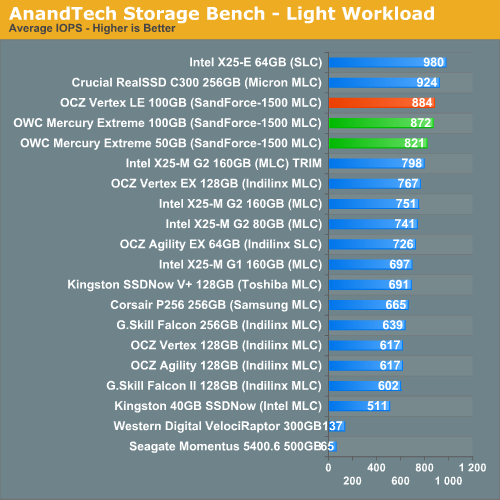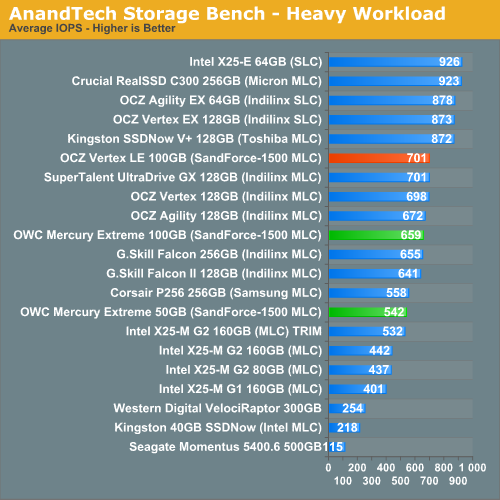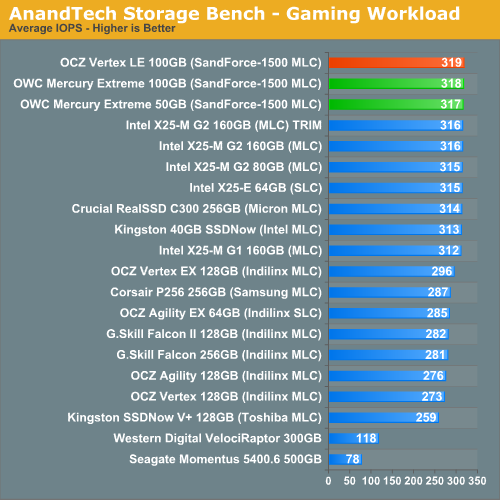OWC Mercury Extreme SSD - First Look at a 50GB SandForce Drive
by Anand Lal Shimpi on February 26, 2010 12:00 AM EST- Posted in
- Storage
AnandTech Storage Bench
Note that our 6Gbps controller driver isn't supported by our custom storage bench here, so the C300 results are only offered in 3Gbps mode.
The first in our benchmark suite is a light usage case. The Windows 7 system is loaded with Firefox, Office 2007 and Adobe Reader among other applications. With Firefox we browse web pages like Facebook, AnandTech, Digg and other sites. Outlook is also running and we use it to check emails, create and send a message with a PDF attachment. Adobe Reader is used to view some PDFs. Excel 2007 is used to create a spreadsheet, graphs and save the document. The same goes for Word 2007. We open and step through a presentation in PowerPoint 2007 received as an email attachment before saving it to the desktop. Finally we watch a bit of a Firefly episode in Windows Media Player 11.
There’s some level of multitasking going on here but it’s not unreasonable by any means. Generally the application tasks proceed linearly, with the exception of things like web browsing which may happen in between one of the other tasks.
The recording is played back on all of our drives here today. Remember that we’re isolating disk performance, all we’re doing is playing back every single disk access that happened in that ~5 minute period of usage. The light workload is composed of 37,501 reads and 20,268 writes. Over 30% of the IOs are 4KB, 11% are 16KB, 22% are 32KB and approximately 13% are 64KB in size. Less than 30% of the operations are absolutely sequential in nature. Average queue depth is 6.09 IOs.
The performance results are reported in average I/O Operations per Second (IOPS):

In our light workload we see a small performance drop from the 100GB to 50GB capacity point. It's nothing tremendous though and definitely not noticeable in real world usage. Other than the usual performance degradation issues you see with running an SSD close to max capacity, you shouldn't really see any difference in performance between a 50GB or a 100GB SandForce drive.
If there’s a light usage case there’s bound to be a heavy one. In this test we have Microsoft Security Essentials running in the background with real time virus scanning enabled. We also perform a quick scan in the middle of the test. Firefox, Outlook, Excel, Word and Powerpoint are all used the same as they were in the light test. We add Photoshop CS4 to the mix, opening a bunch of 12MP images, editing them, then saving them as highly compressed JPGs for web publishing. Windows 7’s picture viewer is used to view a bunch of pictures on the hard drive. We use 7-zip to create and extract .7z archives. Downloading is also prominently featured in our heavy test; we download large files from the Internet during portions of the benchmark, as well as use uTorrent to grab a couple of torrents. Some of the applications in use are installed during the benchmark, Windows updates are also installed. Towards the end of the test we launch World of Warcraft, play for a few minutes, then delete the folder. This test also takes into account all of the disk accesses that happen while the OS is booting.
The benchmark is 22 minutes long and it consists of 128,895 read operations and 72,411 write operations. Roughly 44% of all IOs were sequential. Approximately 30% of all accesses were 4KB in size, 12% were 16KB in size, 14% were 32KB and 20% were 64KB. Average queue depth was 3.59.

Crank up the IOPS and our 50GB drive stops doing so well. I should point out that despite its fall from grace, the 50GB OWC drive is still as fast as the 160GB Intel X25-M G2. While there's indeed a drop in random write speed, it doesn't appear to be a crippling drop.
Our final test focuses on actual gameplay in four 3D games: World of Warcraft, Batman: Arkham Asylum, FarCry 2 and Risen, in that order. The games are launched and played, altogether for a total of just under 30 minutes. The benchmark measures game load time, level load time, disk accesses from save games and normal data streaming during gameplay.
The gaming workload is made up of 75,206 read operations and only 4,592 write operations. Only 20% of the accesses are 4KB in size, nearly 40% are 64KB and 20% are 32KB. A whopping 69% of the IOs are sequential, meaning this is predominantly a sequential read benchmark. The average queue depth is 7.76 IOs.

We've already shown that read speeds are no lower with the 50GB drive, and thus our gaming workload which involves mostly texture/level loads off of the SSD shows no difference between the various capacity points of SandForce drives. We're still very bottlenecked by 3Gbps SATA here.










74 Comments
View All Comments
Kiru - Monday, March 1, 2010 - link
I've bought a bunch of stuff from OWC (3 external Fire wire drives, and 18 gigs of memory), and had no issues with RMAs when I've needed to (the power supply for one of my externals died). I've had just as many issues with faulty product from New Egg as from anywhere else. But that refurb story IS definitely a pisser. I'm surprised they didn't work with you on that.mobilehavoc - Saturday, February 27, 2010 - link
It's pricey at $800 but still cheaper than the OCZ Vertex LE. I'll be running it in a Macbook with Snow Leopard so internal GC is a nice feature since no TRIM support.Any chance these will be upgradeable via firmware in the future? Or is it you buy the drive and that's it? I'm just nervous about buying something that may not be properly supported for times to come.
Di22yDucRydr1198 - Saturday, February 27, 2010 - link
Do any SSDs support this format which is starting to appear on some conventional HDDs? If one has an Advanced format HDD for storage and a SSD for OS and apps, will the two work together without a hitch?Why is that the Crucial RealSSD C300 256GB falls off so dramatically on the 4k random write aligned to 512-byte sectors?
Thanks for your efforts on this and all the preceeding SSD articles.
Griswold - Sunday, February 28, 2010 - link
I dont think there needs to be advanced format compatibility with SSDs.hyc - Monday, March 1, 2010 - link
And you're completely wrong. Advanced format brings similar benefits to SSDs as for HDDs. Not to mention that most SSDs are already using multiple-of-4KB erase blocks, so it actually has *more* benefit than for HDDs.Anand, your "aligned" random write result for the 50GB drive looks identical to your unaligned result. This looks like a test error to me. At worst, the difference in peak performance should be a factor of 2, due to using half as many channels in the 50GB drive vs the 100GB drive. I think you need to reformat that drive and repeat that test.
kunedog - Saturday, February 27, 2010 - link
At last we get an acknowledgement of the market prices of the G2 X-25M, now that they're finally where they were supposed to be at release. It only took six months for your predictions to come true!http://www.anandtech.com/storage/showdoc.aspx?i=36...">http://www.anandtech.com/storage/showdoc.aspx?i=36...
buzznut - Saturday, February 27, 2010 - link
There are a lot of comments here, so I don't expect this to be read. I am going under the assumption that the data for the Kingston SSD-v 40GB will be the same for the Intel 40GB drive. Many of us have purchased the Intel 40GB as a boot drive. Unfortunately I rarely see it in any benchmarks.I was wondering if there were any plans to do an article on raid performance. Also, are drive manufacturers planning on including trim support for raid at some point? Could we expect a firmware upgrade for this, or would it be for newer drives only?I understand that garbage collection is still available, but that's not the same is it?
I know that filling a drive to capacity is bad, but I have heard that one might leave anywhere from 10%-25% space available on a typical SSD. I have been paranoid about ruining the performance of my drive, so I have been running it at half capacity. Is there a sweet spot between capacity and performance on these smaller 40 GB drives?
Also would any of you recommend adding a second drive in raid 0? It seems to me to be an inexpensive way of adding capacity and performance without shelling out $200+ for a new higher capacity drive (which my wife will surely not approve). Again I am hesitant for the lack of trim support in raid. Will this require much more maintenance on the drive(s)?
greenguy - Saturday, February 27, 2010 - link
As another data point, I have 3 of these drives. I usually just read the kingston 40GB figure as it is the same drive. Performance degradation is something that increases as you read and write to the drive more. The less of this you do, the longer it will last in a near-virgin state.But yeah, I am interested in the questions you ask as well.
jimhsu - Saturday, February 27, 2010 - link
I'm curious about the unaligned vs aligned writes. How are these being set up: formatting NTFS with either 512 bytes or 4096 bytes allocation units? Or something else?Also, being an owner of a X25-M G2, I see that earlier generation drives don't have much variation between the two, while these new generation drives have dramatic variation. How does this translate into real-life performance metrics (i.e. the anandtech bench test)?Are there situations where failing to take advantage of aligned 4K leads to a severe performance impact, compared to the new drives?
semo - Saturday, February 27, 2010 - link
Any chance of seeing articles about PCI-E SSDs? Or are they not being talked about due to cost and/or lack of TRIM?